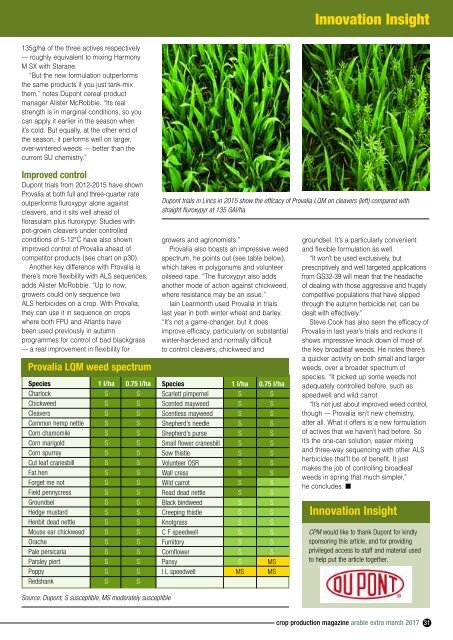In this issue..
CPM-March-Extra-2017
CPM-March-Extra-2017
Create successful ePaper yourself
Turn your PDF publications into a flip-book with our unique Google optimized e-Paper software.
<strong>In</strong>novation <strong>In</strong>sight<br />
135g/ha of the three actives respectively<br />
–– roughly equivalent to mixing Harmony<br />
M SX with Starane.<br />
“But the new formulation outperforms<br />
the same products if you just tank-mix<br />
them,” notes Dupont cereal product<br />
manager Alister McRobbie. “Its real<br />
strength is in marginal conditions, so you<br />
can apply it earlier in the season when<br />
it’s cold. But equally, at the other end of<br />
the season, it performs well on larger,<br />
over-wintered weeds –– better than the<br />
current SU chemistry.”<br />
Improved control<br />
Dupont trials from 2012-2015 have shown<br />
Provalia at both full and three-quarter rate<br />
outperforms fluroxypyr alone against<br />
cleavers, and it sits well ahead of<br />
florasulam plus fluroxypyr. Studies with<br />
pot-grown cleavers under controlled<br />
conditions of 5-12°C have also shown<br />
improved control of Provalia ahead of<br />
competitor products (see chart on p30).<br />
Another key difference with Provalia is<br />
there’s more flexibility with ALS sequences,<br />
adds Alister McRobbie. “Up to now,<br />
growers could only sequence two<br />
ALS herbicides on a crop. With Provalia,<br />
they can use it in sequence on crops<br />
where both FPU and Atlantis have<br />
been used previously in autumn<br />
programmes for control of bad blackgrass<br />
–– a real improvement in flexibility for<br />
Provalia LQM weed spectrum<br />
Species 1 l/ha 0.75 l/ha<br />
Charlock S S<br />
Chickweed S S<br />
Cleavers S S<br />
Common hemp nettle S S<br />
Corn chamomile S S<br />
Corn marigold S S<br />
Corn spurrey S S<br />
Cut leaf cranesbill S S<br />
Fat hen S S<br />
Forget me not S S<br />
Field pennycress S S<br />
Groundsel S S<br />
Hedge mustard S S<br />
Henbit dead nettle S S<br />
Mouse ear chickweed S S<br />
Orache S S<br />
Pale persicaria S S<br />
Parsley piert S S<br />
Poppy S S<br />
Redshank S S<br />
Dupont trials in Lincs in 2015 show the efficacy of Provalia LQM on cleavers (left) compared with<br />
straight fluroxypyr at 135 GAI/ha.<br />
growers and agronomists.”<br />
Provalia also boasts an impressive weed<br />
spectrum, he points out (see table below),<br />
which takes in polygonums and volunteer<br />
oilseed rape. “The fluroxypyr also adds<br />
another mode of action against chickweed,<br />
where resistance may be an <strong>issue</strong>.”<br />
Iain Learmonth used Provalia in trials<br />
last year in both winter wheat and barley.<br />
“It’s not a game-changer, but it does<br />
improve efficacy, particularly on substantial<br />
winter-hardened and normally difficult<br />
to control cleavers, chickweed and<br />
Species 1 l/ha 0.75 l/ha<br />
Scarlett pimpernel S S<br />
Scented mayweed S S<br />
Scentless mayweed S S<br />
Shepherd’s needle S S<br />
Shepherd’s purse S S<br />
Small flower cranesbill S S<br />
Sow <strong>this</strong>tle S S<br />
Volunteer OSR S S<br />
Wall cress S S<br />
Wild carrot S S<br />
Read dead nettle S S<br />
Black bindweed S S<br />
Creeping <strong>this</strong>tle S S<br />
Knotgrass S S<br />
C F speedwell S S<br />
Fumitory S S<br />
Cornflower S S<br />
Pansy S MS<br />
I L speedwell MS MS<br />
groundsel. It’s a particularly convenient<br />
and flexible formulation as well.<br />
“It won’t be used exclusively, but<br />
prescriptively and well targeted applications<br />
from GS32-39 will mean that the headache<br />
of dealing with those aggressive and hugely<br />
competitive populations that have slipped<br />
through the autumn herbicide net, can be<br />
dealt with effectively.”<br />
Steve Cook has also seen the efficacy of<br />
Provalia in last year’s trials and reckons it<br />
shows impressive knock down of most of<br />
the key broadleaf weeds. He notes there’s<br />
a quicker activity on both small and larger<br />
weeds, over a broader spectrum of<br />
species. “It picked up some weeds not<br />
adequately controlled before, such as<br />
speedwell and wild carrot.<br />
“It’s not just about improved weed control,<br />
though –– Provalia isn’t new chemistry,<br />
after all. What it offers is a new formulation<br />
of actives that we haven’t had before. So<br />
it’s the one-can solution, easier mixing<br />
and three-way sequencing with other ALS<br />
herbicides that’ll be of benefit. It just<br />
makes the job of controlling broadleaf<br />
weeds in spring that much simpler,”<br />
he concludes. ■<br />
<strong>In</strong>novation <strong>In</strong>sight<br />
CPM would like to thank Dupont for kindly<br />
sponsoring <strong>this</strong> article, and for providing<br />
privileged access to staff and material used<br />
to help put the article together.<br />
Source: Dupont; S susceptible, MS moderately susceptible<br />
crop production magazine arable extra march 2017<br />
31


